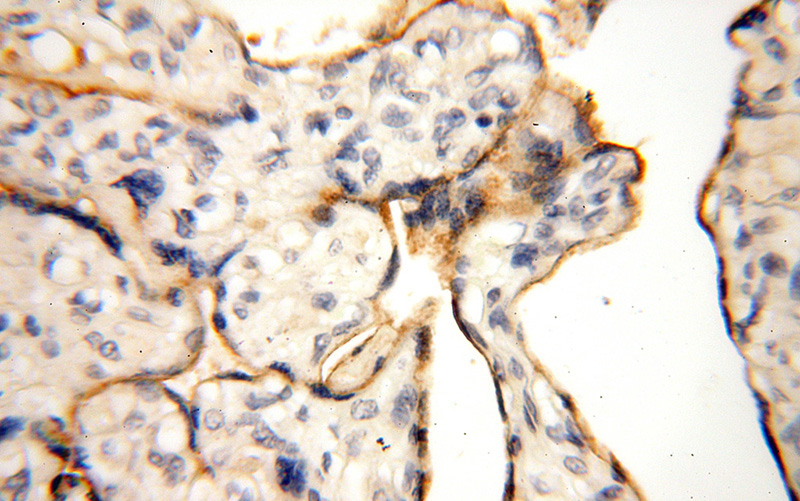-
Product Name
LOX antibody
- Documents
-
Description
LOX Rabbit Polyclonal antibody. Positive IHC detected in human placenta tissue, human heart tissue, human skin tissue, human stomach cancer tissue. Positive IP detected in mouse skeletal muscle tissue. Positive WB detected in Jurkat cells, A375 cells, MKN-45 cells, mouse skeletal muscle tissue, NIH/3T3 cells, SGC-7901 cells. Observed molecular weight by Western-blot: 32kd or 45-47kd
-
Tested applications
ELISA, WB, IHC, IP
-
Species reactivity
Human, Mouse; other species not tested.
-
Alternative names
LOX antibody; lysyl oxidase antibody; Protein lysine 6 oxidase antibody
-
Isotype
Rabbit IgG
-
Preparation
This antibody was obtained by immunization of LOX recombinant protein (Accession Number: NM_002317). Purification method: Antigen affinity purified.
-
Clonality
Polyclonal
-
Formulation
PBS with 0.02% sodium azide and 50% glycerol pH 7.3.
-
Storage instructions
Store at -20℃. DO NOT ALIQUOT
-
Applications
Recommended Dilution:
WB: 1:200-1:2000
IP: 1:200-1:2000
IHC: 1:20-1:200
-
Validations

Jurkat cells were subjected to SDS PAGE followed by western blot with Catalog No:112298(LOX antibody) at dilution of 1:600

Immunohistochemical of paraffin-embedded human placenta using Catalog No:112298(LOX antibody) at dilution of 1:100 (under 10x lens)

Immunohistochemical of paraffin-embedded human placenta using Catalog No:112298(LOX antibody) at dilution of 1:100 (under 40x lens)

IP Result of anti-LOX (IP:Catalog No:112298, 3ug; Detection:Catalog No:112298 1:500) with mouse skeletal muscle tissue lysate 2000ug.
-
Background
LOX is a member of a multigene family (LOX, LOXL, LOXL2, LOXL3, and LOXL4). Lysyl oxidase (LOX), a copper-dependent enzyme, plays a critical role in the formation and repair of the extracellularmatrix (ECM) by catalyzing the crosslinking of elastin and collagen. LOX expression appears to be upregulated in malignancies and has recently been suggested to play a role in regulating tumor metastasis. It is synthesized as a 50 kDa proenzyme, secreted, and processed into an 32 kDa mature, active enzyme and an 18-kDa propeptide.
-
References
- Shu G, Mi X, Cai J. Brucine, an alkaloid from seeds of Strychnos nux-vomica Linn., represses hepatocellular carcinoma cell migration and metastasis: the role of hypoxia inducible factor 1 pathway. Toxicology letters. 222(2):91-101. 2013.
- Cowling RT, Yeo SJ, Kim IJ. Discoidin domain receptor 2 germline gene deletion leads to altered heart structure and function in the mouse. American journal of physiology. Heart and circulatory physiology. 307(5):H773-81. 2014.
- Jiang J, Sun A, Wang Y, Deng Y. Increased expression of Talin1 in the eutopic and ectopic endometria of women with adenomyosis. Gynecological endocrinology : the official journal of the International Society of Gynecological Endocrinology. 2016.
Related Products / Services
Please note: All products are "FOR RESEARCH USE ONLY AND ARE NOT INTENDED FOR DIAGNOSTIC OR THERAPEUTIC USE"
